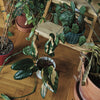Poisonous plants
Photo: Dieffenbachia is one of the most toxic houseplants. Especially for small animals and the smallest children.
Non-poisonous indoor plants
If you don't have the time, desire or energy to take care of poisonous indoor plants, children or pets all at once and you also want to save your nerves, you can breathe a sigh of relief. There is still a large and varied number of beautiful and unpretentious rooms that can decorate your home.
To begin with, we present a list of several plants that have not been found to be toxic. This means that their content of possible toxins does not exceed the normal level of occurrence, for example, in frequently used vegetables - so their cultivation at home is harmless. Despite this, we do not recommend trying to consume them. In our e-shop you will find these plants suitable for pets
List of non-toxic roommates:
- African violets
- Asplenium
- Begonia
- Calathea
- Crassula
- Dragons
- Ficuses
- Gynors
- Hoye (wax)
- Chlorophytum (vegetable)
- Ferns
- Kalanchoe
- Marantha
- Peperomia
- Piles
- Schefflery
- Tradescantia (drops)
- Christmas cactus
Poisonous maids in the household and without accidents!
Houseplants are a very diverse group - differing mainly in the appearance of leaves, flowers or the way they grow. Among houseplants, we also find some that, for example, clean the air or produce more oxygen than others - we have already written an article about these superheroes of the plant world. But did you know that houseplants can also be toxic and poisonous? And don't you have any of them at home? In our article, we will introduce you to some poisonous or toxic representatives.
Toxic and poisonous houseplants
Plants that contain toxins are usually labeled as toxic. There are many toxins and when ingested they can cause damage most often in the stomach, heart, kidneys or skin (rashes). The toxins that some houseplants contain are especially dangerous for pets (most often dogs and cats) or small children. Commonly occurring toxins include solanine, oxalates or glycosines, which we will briefly introduce.
Solanine : this is a toxic glycoalkaloid that takes the form of a white crystalline substance. We would normally find solanine in, for example, potatoes or eggplant. This toxin is produced by plants to protect themselves from various pests, insects or animals in general. If ingested, it causes irritation of the digestive tract and spasms, resulting in vomiting or diarrhea. It can also cause inflammation.
Oxalates : these are so-called oxalates - salts of oxalic acid. Some plants store oxalate crystals in their tissues, which when ingested can cause irritation and swelling (for example of the mouth, tongue, throat), which in extreme cases can lead to suffocation. We would find these toxins, for example, in syngonias ( syngonium podophyllum ), caladiums, diffenbachias ( diffenbachia seguine) , philodendrons ( philodendron hastatum, cordatum, selloum) and pothos ( pothos aureus ), scindapsus or monsters ( monstera deliciosa ). They are also commonly found in small amounts in spinach, kaku, blueberries or tea leaves.
Glycosides : These are derivatives of cyclic carbohydrates containing carbon, hydrogen and oxygen. Glycosides serve as sources of nutrients for plants. Some glycosides are toxic and can cause irregular heartbeat, tremors or seizures, weakness or collapse if ingested. Toxic glycosides can be found, for example, in lilies of the valley, poinsettia, chicory, plantain, buckwheat or division.

Photo: Even the popular Oleander, which we especially fell in love with on our outdoor terraces, is poisonous if ingested.
The most common poisonous houseflies in households
There are not a few species of poisonous houseflies, so there are many lists of them, which differ according to the focus on the level of toxicity or frequency of occurrence in households. At the same time, individual plants are toxic to humans, dogs or cats in different ways. At the same time, we can include the following among the 10 most commonly grown poisonous houseplants:
- Philodendrons : slightly toxic to humans, toxic to dogs and cats
- Eipremnum and Scindapsus : toxic to humans, dogs and cats
- Syngonia : slightly toxic to humans, dogs and cats
- Lily: moderately toxic to humans, dogs and toxic to cats
- Spathiphyllum : toxic to humans, dogs and cats
- Dieffenbachia : extremely toxic to humans, dogs and cats
- Oleanders: extremely toxic to humans, dogs and cats
- Caladia: toxic to humans, dogs and cats
- Sansevieria (mother-in-law's tongue): slightly toxic to humans, moderately toxic to dogs and cats
- Ivy: slightly toxic to humans, toxic to dogs and cats
Diffenbachia: ingestion of this plant by humans or animals may cause extreme pain in the mouth, salivation and swelling or numbness in the throat. Diaffenbachia is one of the most toxic houseplants and can be life-threatening if a large amount of leaf is ingested.
Philodendron: contains calcium oxalate crystals and is therefore slightly toxic to humans, toxic to dogs and cats. When ingested, only mild symptoms of poisoning appear in humans, such as swelling around the mouth, rash or irritation of the digestive tract. In dogs and cats, even more serious symptoms of poisoning such as convulsions, seizures, painful conditions and swelling may appear.
Epipremnum and Scindapsus : the following symptoms may occur in humans after ingestion: burning of the mouth, skin irritation, swelling or vomiting and diarrhea. In dogs and cats, ingestion may cause drooling, swelling and associated suffocation or nausea. If an animal eats a large part of the plant, kidney failure can occur.
Syngonium : may cause skin irritation, stomach upset or vomiting in humans and animals.
Lily: are a diverse plant group where we would find both toxic and non-toxic varieties. Specific species, for example wild lily, Asiatic or rubrum , can be toxic to humans and animals. They are said to be more toxic especially to cats, which can cause vomiting, lethargy and kidney failure. In humans, poisoning is accompanied by vomiting, stomach irritation and headache.
Lopatkovec: Even though it is called a peace lily (from the English Peace Lily ), the scapula is not a real lily. Despite this, it is equally toxic to humans and animals. In humans, intoxication may cause vomiting, diarrhea, or burning and swelling of the mouth, tongue, and throat, which may lead to difficulty speaking and swallowing. Although there are relatively controversial opinions regarding the toxicity of stipule to pets, it is nevertheless included in lists of plants toxic to animals. Poisoning is manifested by drooling, dehydration and diarrhea or vomiting.
Oleander: it is a beautiful shrub that may seem gentle and innocent, but even ingesting its honeyed nectar can cause poisoning. This is manifested in humans and animals by tremors and convulsions, dizziness, vomiting and/or cardiac arrhythmia.
Caladium: all parts of the plant are considered toxic. Swallowing them can cause painful burning of the mouth and tongue, swelling and suffocation. Animals may experience vomiting, staggering, excessive salivation and shortness of breath.
Mother-in-law's tongue : the level of toxicity in humans is low and ingestion of the plant may lead to short-term symptoms - salivation, mouth pain, nausea. In rare cases, a dermatological reaction and skin irritation may occur. In animals, it can cause excessive salivation, pain and nausea up to vomiting and diarrhea.
Ivy: may cause skin irritation, burning in the mouth, convulsions or fever in humans if ingested. Dogs and cats may experience diarrhea, shortness of breath, tremors or vomiting, and staggering.

Photo: Working with plants can be fun even for the little ones, but it's better to check and clarify what to avoid.
Safety first
Plants, together with children and animals, can coexist without problems in households. However, if you own some of the toxic maids and at the same time there are children or pets in your household, you should be careful to avoid poisoning.
Poisoning can occur in several ways:
- By looking at or touching the leaves
- Ingestion of berries, flowers or roots
- By swallowing the soil
- By drinking water from a saucer
- By skin contact with the sap or juices that the plant produces
Keeping an eye on small children or pets can be very challenging, after all they are all very curious and need to thoroughly explore or even taste everything. Therefore, it is advisable to either buy non-poisonous plants for the home, or to follow basic safety rules.
How to coexist with pets, children and poisonous maids?
Do you have children or animals at home and at the same time want to grow beautiful philodendrons or syngonia (or even other poisonous species)? It is possible, but you must pay attention to the observance of basic safety rules.
Basic safety rules:
- We keep plants out of the reach of children and animals (especially dogs)
- We take care of the plants regularly and clean up withered or fallen leaves
- We cut the plants regularly (so that the child cannot reach them)
- When handling (transplanting), use protective gloves or wash your hands thoroughly
- We teach children not to touch or eat plants
- We always prepare fresh water for the pets so that they are not tempted to drink from saucers and flower pots
- Instead of watering in pots, we can use self-watering flower pots
We can also mark toxic plants with a specific label or picture. It will make it easier for us to navigate between the plants we need to watch out for. Pictures or signs can also help teach children which plants are potentially dangerous to them.

Photo: Cats like to nibble on plants and the tips of leaves and occasionally grind their claws against thicker trunks. If you have a curious cat at home, it is better to adapt toxic plants so that she cannot access them.
Poisonous plants and cats
Cats are a specific group potentially threatened by poisonous plants. Small children or dogs are easy to control, and all dangerous plants can simply be removed out of their reach. However, cats are so nimble that they can get practically everywhere and to everything.
Cultivation of poisonous plants is thus considered by cat owners. Some cats are not interested in plants at all, others tend to nibble on them all the time. So it is primarily for the consideration of the specific owner.
In general, cats tend to be attracted to plants with thin and long grass-like leaves. They are not very interested in plants with large, massive leaves. Tasting the plants could also limit cats from acquiring the so-called cat's nettle (nepeta cataria) , which could attract them more than other plants and which is harmless to cats.
You can try citrus to deter cats from poisonous plants. In general, cats do not smell citrus and tend to avoid it. You can therefore try to place citrus peels (tangerines, oranges, lemons) around the poisonous houseplant (for example, around a flower pot, on clay). Such a measure could teach cats to avoid a particular roommate, which is certainly worth a try.
Don't be afraid!
Well, that's all, we hope we didn't scare you too much. There are still far more dangerous things in the home than houseplants, but you know the saying Who is prepared is not surprised! Therefore, if you have discovered that you have poisonous bedbugs at home, do not panic - you do not have to get rid of them right away. If your children or pets are not interested in them, there is no indication that a fatal accident should occur. On the contrary, it is actually an advantage now that you know that the plant is toxic and you can therefore keep an eye on it and other members of the household.
Write for advice!
If you are still not sure about growing houseplant, whether or not it is a risk for children or animals, do not be afraid to write to us, we will be happy to advise you!
Author: B.Sc. Jana Beránková
-
Posted in
Zajímavosti a tipy





